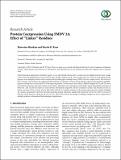Files in this item
Protein coexpression using FMDV 2A : effect of “linker” residues
Item metadata
| dc.contributor.author | Minskaia, Ekaterina | |
| dc.contributor.author | Ryan, Martin D. | |
| dc.date.accessioned | 2013-07-23T14:31:03Z | |
| dc.date.available | 2013-07-23T14:31:03Z | |
| dc.date.issued | 2013-04 | |
| dc.identifier | 60332211 | |
| dc.identifier | 30268f95-4fef-42ae-9607-3c9936d3873c | |
| dc.identifier | 000320794800001 | |
| dc.identifier | 84880154492 | |
| dc.identifier.citation | Minskaia , E & Ryan , M D 2013 , ' Protein coexpression using FMDV 2A : effect of “linker” residues ' , BioMed Research International . https://doi.org/10.1155/2013/291730 | en |
| dc.identifier.issn | 2314-6133 | |
| dc.identifier.other | ORCID: /0000-0002-0012-0614/work/47136053 | |
| dc.identifier.uri | https://hdl.handle.net/10023/3864 | |
| dc.description | This article was made open access through BIS OA funding. The research was supported by the MRC. | en |
| dc.description.abstract | Many biomedical applications absolutely require, or are substantially enhanced by, coexpression of multiple proteins from a single vector. Foot-and-mouth disease virus 2A (F2A) and “2A-like” sequences (e.g., Thosea asigna virus 2A; T2A) are used widely for this purpose since multiple proteins can be coexpressed by linking open reading frames (ORFs) to form a single cistron. The activity of F2A “cleavage” may, however, be compromised by both the use of shorter versions of F2A and the sequences (derived from multiple-purpose cloning sites) used to link F2A to the upstream protein. To characterise these effects, different lengths of F2A and T2A were inserted between green and cherry fluorescent proteins. Mutations were introduced in the linker region immediately upstream of both F2A- and T2A-based constructs and activities determined using both cell-free translation systems and transfected cells. In shorter versions of F2A, activity may be affected by both the C-terminal sequence of the protein upstream and, equally strikingly, the residues immediately upstream introduced during cloning. Mutations significantly improved activity for shorter versions of F2A but could decrease activity in the case of T2A. These data will aid the design of cloning strategies for the co-expression of multiple proteins in biomedical/biotechnological applications. | |
| dc.format.extent | 12 | |
| dc.format.extent | 2714717 | |
| dc.language.iso | eng | |
| dc.relation.ispartof | BioMed Research International | en |
| dc.subject | Multiple proteins | en |
| dc.subject | Single vector | en |
| dc.subject | Foot-and-mouth disease virus | en |
| dc.subject | Open reading frames (ORFs) | en |
| dc.subject | Cistron | en |
| dc.subject | F2A | en |
| dc.subject | T2A | en |
| dc.subject | C-terminal sequence | en |
| dc.subject | Cloning strategies | en |
| dc.subject | Biomedical applications | en |
| dc.subject | Biotechnological applications | en |
| dc.subject | Mouth-disease virus | en |
| dc.subject | Ribosome entry sites | en |
| dc.subject | Embryonic stem-cells | en |
| dc.subject | Open reading frame | en |
| dc.subject | Retroviral vector | en |
| dc.subject | Signal sequences | en |
| dc.subject | Gene-expression | en |
| dc.subject | T-cells | en |
| dc.subject | Cleavage | en |
| dc.subject | Peptide | en |
| dc.subject | Q Science | en |
| dc.subject.lcc | Q | en |
| dc.title | Protein coexpression using FMDV 2A : effect of “linker” residues | en |
| dc.type | Journal article | en |
| dc.contributor.sponsor | Medical Research Council | en |
| dc.contributor.institution | University of St Andrews. School of Biology | en |
| dc.contributor.institution | University of St Andrews. Biomedical Sciences Research Complex | en |
| dc.identifier.doi | https://doi.org/10.1155/2013/291730 | |
| dc.description.status | Peer reviewed | en |
| dc.identifier.grantnumber | G0901002 | en |
This item appears in the following Collection(s)
Items in the St Andrews Research Repository are protected by copyright, with all rights reserved, unless otherwise indicated.

